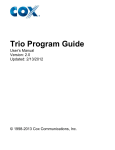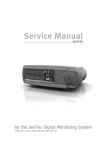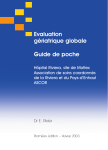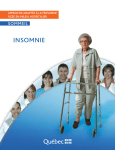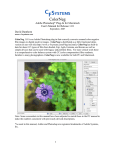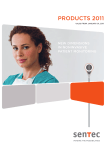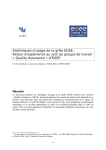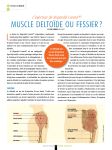Download PAIN SCREENING: - Vanderbilt University Medical Center
Transcript
PAIN SCREENING: Training Module Page 1 of 25 Table of Contents Section: Page: About this module .............................................................................................................. 3 Learning objectives............................................................................................................ 4 Step 1: Understand the problem, the solution.................................................................... 5 - 6 Step 2: Pain screening ...................................................................................................... 7 - 10 Next steps toward pain management ............................................................................... 11 - 14 FAQs ................................................................................................................................ 15 - 18 Related Studies ................................................................................................................. 19 - 21 Pain screening forms ........................................................................................................ 22 Chronic pain assessment: Resident interview form ................................................... 23 Pain quality indicators: Medical record data and scoring form................................... 24 - 25 Page 2 of 25 About This Training Module T his training module presents instructions and tools for screening nursing home residents for chronic pain. It starts with a discussion of the problem— inadequate pain detection—and presents an overview of the solution. CONTACT US We’ve tried to be comprehensive, but if there is something you can’t find, or if you have unanswered questions, comments, or concerns, please feel free to contact us at the Center for Quality Aging: The next section describes how to conduct pain screenings, the first step in a series of tasks that lead to better care and quality of life for residents. The tasks described here all fall within the work domain of licensed nurses and nurse aides; in other words, you have the power to make a difference in the lives of your residents. Elsewhere in this module—Next Steps, Links, FAQs, and Related Studies—we provide guidance and referrals to other resources to help you accomplish the pain management steps that follow screening. And you go online to chat with other healthcare providers about the topic via our Discussion Board. Page 3 of 25 Vanderbilt University Medical Center Center for Quality Aging 1611 21st Ave South Rm S-1121 Medical Center North Nashville, TN 37232-2400 www.vanderbiltcqa.org Learning Objectives A t the end of this training module, you will be able to: Identify at least one common oversight in the pain management process used in many nursing homes. Explain the importance of assessing pain among cognitively impaired nursing home residents. Demonstrate knowledge of: 1) who can screen nursing home residents for presence of pain, and 2) when these screenings should be conducted. Conduct pain screenings in all communicative nursing home residents. Identify one valid instrument for assessing pain among noncommunicative residents. Demonstrate knowledge of three care management steps that follow pain screening for residents who report pain. All procedures presented in this module are in accordance with the federal regulations that govern nursing home care and best practice guidelines for pain management. Page 4 of 25 Step 1: Understand the Problem, the Solution In most nursing homes today, pain among residents is under-detected and under-treated. The good news is that we have the tools and knowledge to effectively manage most pain. “THERE IS MUCH PAIN THAT IS QUITE NOISELESS” T his observation by British novelist George Eliot seems especially true in nursing homes, particularly among long-stay residents, whose pain tends to be chronic, low-grade, and silent. “Few people with chronic pain still cry out or moan or have sweating or a rapid heartbeat,” writes physician Joanne Lynn, a specialist in palliative care (1). “Most just reduce activity and withdraw from interaction. It takes having an attentive and enduring caregiver to notice…” By most accounts, nursing home providers are not noticing. Findings from recent studies reveal the following: An estimated 45% to 83% of nursing home residents are reported to be in pain, most suffering symptoms of osteoarthritis and related musculoskeletal problems (2, 3). Despite this high prevalence, pain in nursing homes is under-detected and therefore under-treated. In two studies, physicians had not documented pain in 30%-40% of nursing home residents who reported pain symptoms when independently assessed by research staff (4, 5). In one of our recent studies, among the residents reporting pain, only 42% were receiving pain medication, though 80% said they would like to (5). This study also found that licensed nurse assessments of pain were documented weekly; however, more than 50% of the residents who reported pain symptoms to us had nurse pain scores of zero during the past four consecutive weeks (5). In another study, we found that of the 309 residents who reported chronic pain in interviews with research staff, only 115, or 37.2%, had documentation of pain on their most recent Minimum Data Set (MDS) assessment (6). Moreover, this study showed that as a resident’s cognitive impairment increased, nursing home staff were increasingly less likely to document pain presence on the MDS, a finding that suggests that the staff were using subjective criteria to evaluate pain among residents (6). PAIN MANAGEMENT: JUST DO IT The literature on pain management lists a litany of reasons why pain goes underdetected and under-treated in nursing homes—lack of staff time, lack of staff knowledge, communication barriers, cultural barriers, social barriers—the list goes on. “There is no reason for folks to be suffering with pain on a daily basis. We have the tools to take care of it, the knowledge to take care it, we just need to do it.” In fact, says Dr. Michael Gloth, associate professor of medicine at Johns Hopkins University in Baltimore, Maryland, “There is no reason for folks to be suffering with pain Page 5 of 25 on a daily basis. We have the tools to take care of it, the knowledge to take care it, we just need to do it (7).” IT STARTS WITH SCREENING So where do you start? With an initial pain screening, followed by a comprehensive assessment and appropriate treatment, and then regular reassessments and ongoing monitoring of all residents to detect any changes in status. In the next section, we present instructions and tools for accomplishing the first step: screening for the presence of chronic pain among nursing home residents. documentation of pain assessments by both licensed nurses and physicians. What do you find? Are assessments documented for all residents? How are assessments conducted? How many residents have pain documented? Is there documentation of physician follow-up for these residents? Share your findings with us; please contact us. We hope to post your feedback on future updates to our website. REFERENCES 1. Before you read on, however, consider these program prerequisites. First, enlist top-level support from a managerial “champion” to facilitate adoption of this new screening procedure by licensed nurses and direct care staff. One way to recruit help: Hand the likely champion a copy of this module and ask if you two can discuss it after s/he has read it. Have you considered that you yourself might be the champion? Second, read through the module so that, from beginning to end, you know what’s needed to improve pain management. Finally, allow extra time at the beginning to climb the learning curve; staff may need extra reinforcement at the start to establish a new pain screening routine. 2. 3. 4. 5. 6. That said, you should now read on. YOUR ASSIGNMENT Review the medical charts for a random sample of 10-15 residents. Look for Page 6 of 25 Lynn J. (1998). “If a tree falls..”—The sound of suffering in nursing homes. ABCD Exchange; Sept., accessed 12/10/2003 at http://www.mywhatever.com/cifwriter/content/19/abcd1 647.html AGS Panel on Persistent Pain in Older Persons. (2002). The management of persistent pain in older persons. Journal of the American Geriatrics Society; 50:S205-S224. Fox PA, Raina P, Jadad AR. (1999). Prevalence and treatment of pain in older adults in nursing homes and other long-term care institutions: a systematic review. CMAJ; 160:329- 333. Sengstaken EA, King SA. (1993). The problems of pain and its detection among geriatric nursing home residents. Journal of the American Geriatrics Society; 41:541-544Cadogan MP, Schnelle JF, YamamotoMitani N. A MDS prevalence of pain quality indicator: Is it accurate and does it reflect differences in care processes? Journal of Gerontology: Medical Sciences. In press. Chu L, Schnell JF, Cadogan MP, Simmons SF. Using the minimum data set to select nursing home residents for interview about pain. Journal of the American Geriatrics Society, in review. Reuters Health. (2003). Chronic pain often untreated in nursing homes. Accessed 12/10/03 at http://12.31.13.155/HealthNews/reuters/NewsStory021 720032.htm Step 2: Pain Screening Learn how to conduct a simple screening that detects chronic pain in nursing home residents. This first step is a powerful motivator for change, for once pain is acknowledged, it is difficult to not do anything about it. that report a higher prevalence of pain among residents also do a better job of assessing pain and treating it (4). INCLUDE COGNITIVELY IMPAIRED RESIDENTS “Pain is whatever the person says it is, existing whenever (the person) says it does.” ARE YOU LISTENING? A merican novelist Naomi Wolf once wrote: “Pain is real when you get other people to believe in it. If no one believes in it but you, your pain is madness or hysteria.” To which we might add, “…or old age and dementia.” Thus amended, this remark may go a long way toward explaining why official estimates of pain prevalence among nursing home residents (7-9%) are so much lower than actual pain prevalence (45-83%) (references 1-4). The MDS Users Manual for December 2002 has this to say about pain assessment (5): “Ask the resident if he or she has experienced any pain…If the resident has pain, take his or her word for it.” As we will see, it’s that simple. IT STARTS WITH SCREENING Effective pain management starts with an initial screening. The importance of this step goes beyond its first place in a series of tasks that lead to better care and quality of life for residents. It is perhaps more significant as a powerful motivator for change. Though it is natural to defend against it at first, once you awaken to the pain around you it is difficult to not do anything to alleviate it. This very human inclination to ease pain may explain why nursing homes Because “pain is subjective and lacks objective biological markers” (6), self-report of pain by residents “is generally held to be the gold standard of pain assessment” (7). In other words, “pain is whatever the person says it is, existing whenever (the person) says it does” (6). But what if the person is cognitively impaired, as 50% of nursing home residents are? Will this person’s self-report of pain be meaningful? So much is made of this concern that even most studies that have examined pain prevalence in nursing homes have excluded residents with marked cognitive impairment on the assumption that their responses would be unreliable. Among the minority of studies that included cognitively impaired individuals, some have reported a low prevalence of pain among these residents. These findings provide another reason to exclude cognitively impaired residents from further research. One disturbing consequence of this oversight is that cognitively impaired residents may be short-changed on pain management. In a recent study, we found that as cognitive impairment increased among residents with pain, the nursing staff were increasingly less likely to document pain presence. This finding suggests that nursing staff tend to disregard reports of Page 7 of 25 pain by residents with more severe cognitive impairment. OUR RECOMMENDATION: FOUR QUESTIONS TO PAIN SCREENING As it turns out, cognitively impaired residents are remarkably trustworthy reporters about their own subjective pain experience. This conclusion is based on a recent study we conducted in 33 nursing homes with 893 residents (7). No one was excluded based on cognitive impairment. This finding also simplifies the initial pain assessment process. Based on it, our recommendation is: What we found contradicts assumptions and findings from previous studies. First, we found a higher prevalence of pain among cognitively impaired residents than previous studies have reported. We also found that the vast majority of residents, including the most cognitively impaired residents, could provide us with meaningful self-reports of pain when asked four simple YES/NO questions. We designed this study to determine whether a cognitive performance measure derived from the Minimum Data Set (MDS) could accurately identify residents capable of responding to our pain screening interview. Specifically, we used residents’ MDS recall scores, which are calculated from four items on the MDS. Lower scores indicate greater cognitive impairment. Our findings? Among the 79.4% of residents (n=709) with recall scores between 1 and 4, 83% to 97% answered all four questions. Yet even among the most cognitively impaired residents—the 21% with recall scores of 0—52% were able to answer the interview questions. PAIN SCREEENING INSTRUCTIONS A licensed nurse or certified nurse aide should ask all communicative residents directly about pain using these four YES/NO questions: 1. Do you have pain anywhere right now? 2. Does pain ever keep you from sleeping at night? 3. Does your pain ever keep you from participating in activities / doing things you enjoy? 4. Do you have pain every day? Chronic pain is present if the resident answers yes to questions 1-3 or to question 4 alone. These residents need further evaluation and appropriate treatment. Use our pain screening interview form to record results. At a minimum, this screening for chronic pain should be conducted: upon admission, at each quarterly review, and when routinely assessing for pain as a 5th vital sign. This latter finding is in keeping with Parmelee’s assertion that “self reports [of pain in cognitively impaired elderly] are…no less valid than those of cognitively intact individuals (8),” a conclusion that Manz et al. concurred with as well (9). Page 8 of 25 ONE EXCEPTION One exception to our otherwise global recommendation applies to residents who are uncommunicative, or cannot communicate at all. Often, these residents are stroke victims or are in the final stage of Alzheimer’s disease. With these residents, it’s best to use an observational tool such as the Pain Assessment in Advanced Dementia, also known as PAINAD, which is a simple, valid, and reliable five-item instrument for measuring pain in uncommunicative patients (12). DO NOT, however, use the PAINAD to assess pain in patients who can communicate. This is a common but inappropriate use of the tool. ADVANTAGES OF OUR PAIN SCREENING TOOL With its yes/no format, our interview tool is particularly appropriate for use with mild to moderately cognitively impaired residents, many of whom would be unable to respond to the commonly used 10-point pain rating scale (where 0 represents “no pain at all” and 10 signifies “the worst pain I have ever experienced”) or even a visual scale with different facial expressions (10, 11). Licensed nurses, who are now required to assess pain as a “5th vital sign”, often use such a 10-point scale for pain assessment, which may explain why so many residents are inappropriately excluded from pain assessment due to cognitive impairment. In our study, 83% of all of the participating residents completed the interview’s four yes/no questions. Thus, we encourage nurses to use these screening questions, instead of the more complicated and commonly used 10-point scale, for pain assessment. Equally important, this screening interview can be conducted by both licensed nurses and certified nurse aides. It is a screening, not a clinical assessment, which would exclude nurse aides from completing it. It is intended to simply detect the presence of probable chronic pain. Further assessment by a licensed nurse is needed to evaluate pain intensity, location, quality, and associated symptoms. Based on both research and clinical experience, we recommend that licensed nurses administer these screening questions during medication passes. Minimally, licensed nurses should ask the question, “Do you have pain anywhere right now?” during every medication pass as this provides an excellent opportunity to assess pain as a 5th vital sign and the potential need for “prescribed as needed” (PRN) pain medication. If the resident responds, “yes”, to this question, the medication nurse can ask the follow-up question, “Would you like to take some (medicine) for your pain?”. We have demonstrated that asking these two simple questions during morning, afternoon and evening medication passes results in a significant increase in pain detection and PRN pain medication delivery. Moreover, cognitively impaired residents notice the difference in licensed nurse behavior as evidenced by their own self-report that nurses began asking them about pain “more often”. In addition to licensed nurse assessment during medication passes, we also suggest that direct care staff (nurse aides) inquire about pain during morning and evening Activities of Daily Living (ADL) care and/or walking and toileting assistance by asking the resident directly, “Do you have pain anywhere right now?” and being observant of the resident’s expression of pain (e.g., facial grimacing, moaning or groaning) Page 9 of 25 during daily care activities. We have found that residents are more likely to experience and express pain during physical movement (transfer out of bed, toileting, walking, dressing) versus when sitting still or lying in bed. Because joint pain is common among nursing home residents, it makes sense that residents are more likely to experience pain during ADL care delivery, and nurse aides need to be aware of this so that they can communicate the resident’s pain to the licensed nursing staff for further assessment. FOLLOW-UP NEEDED If a resident reports pain during the initial screening interview or during medication pass(es) or ADL care delivery, then further evaluation of pain intensity, location, quality and associated symptoms is needed to guide diagnosis and treatment decisions. Our pain interview includes items about presence, frequency, and effect of pain on residents’ daily lives, but does not have enough specific items upon which to base diagnosis and treatment. Elsewhere in this module - Next Steps, Links, FAQs, Related Studies - we provide guidance and referrals to other resources to help you accomplish the pain management steps that follow screening. YOUR ASSIGNMENT Use our pain screening tool (at the end of the document) to interview a random sample of 5-10 residents. Be sure to interview some residents with mild to moderate cognitive impairment. Tell us how the interviews went; please contact us. How many residents answered all four questions? How many residents reported chronic pain? Did you find the interview tool helpful? Would you recommend its use? We hope to report your feedback for the benefit of others in future updates to this site. REFERENCES 1. Centers for Medicare and Medicaid Services. (2004) Enhanced set of quality measures now available at Medicare’s easier-to-use Nursing Home Compare. Press release accessed 2/22/04 at www.cms.hhs.gov 2. AGS Panel on Persistent Pain in Older Persons. (2002). The management of persistent pain in older persons. Journal of the American Geriatrics Society; 50:S205-S224. 3. Fox PA, Raina P, Jadad AR. (1999). Prevalence and treatment of pain in older adults in nursing homes and other long-term care institutions: a systematic review. CMAJ; 160:329- 333. 4. Cadogan MP, Schnelle JF, Yamamoto-Mitani N. A MDS prevalence of pain quality indicator: Is it accurate and does it reflect differences in care processes? Journal of Gerontology: Medical Sciences. In press. 5. Centers for Medicare and Medicaid Services. Revised long term care resident assessment instrument user’s manual for the Minimum Data Set (MDS), Version 2.0. [On-line] www.cms.hhs.gov. Accessed August 25, 2003. nd 6. McCaffery M., Pasero C. Pain Clinical Manual 2 Edition 1999. 7. Chu L, Schnell JF, Cadogan MP, Simmons SF. Using the minimum data set to select nursing home residents for interview about pain. Journal of the American Geriatrics Society, in review. 8. Parmalee PA, Smith B, Katz IR. (1993). Pain complaints and cognitive status among elderly institutionalized residents. Journal of the American Geriatrics Society; 41:517 – 522. 9. Manz BD, Mosier R, Nusser-Gerlach MA, et al. (2000). Pain assessment in the cognitively impaired and unimpaired elderly. Pain Manag Nurs; 1:106 – 115. 10. Simmons SF, Schnelle JF, Uman GC, Kulvicki AD, Lee KO, and Ouslander JG. (1997). Selecting nursing home residents for satisfaction surveys. The Gerontologist, 37(4):543-550. 11. Norton PG, van Maris B, Soberman L, and Murray M. (1995). Satisfaction of residents and families in logterm care: Construction and application of an instrument. Quality Management in Health Care; 4(3):38-46. 12. Warden V, Hurley AC, Volicer L. (2003). Development and psychometric evaluation of the Pain Assessment in Advanced Dementia (PAINAD) scale. Journal of the American Medical Directors Association; 4(1):9-15. Page 10 of 25 Next Steps Toward Pain Management Learn about the steps that follow pain screening, including treatment and reassessment. Check out other resources that can help nursing home staff better manage pain among residents. TAKE THE NEXT STEP(S) N “… othing is less necessary than pain,” wrote Joseph De Maistre, a French diplomat and philosopher, in 1821. That observation is even truer today, when physicians and patients alike have access to a growing wealth of information about pain management and a rapidly expanding array of pharmacological painkillers. In nursing homes, effective pain management creates a win-win-win scenario for residents, staff, and administrators. For residents, the immediate benefits are as compelling as they are obvious: freedom from pain and improved quality of life. For their part, nursing staff report that problem behaviors among some residents subside when pain is better controlled. Pain relief may also improve a resident’s functional ability, thereby reducing the daily care burden on staff. And for administrators, there’s ample evidence, say experts, that “treating pain saves money in the long run (1).” FOR EFFECTIVE PAIN MANAGEMENT, INVOLVE YOUR PHYSICIANS If you can do only one thing to improve your facility’s pain management program, it should be this: Involve your physicians in the assessment and documentation of pain. Experience shows that when physicians are actively involved in this first assessment step, all the other steps—treatment, reassessment, ongoing monitoring—follow. Physician participation, apparently, helps to set high expectations for pain management among other nursing home staff. With the stage set, the work gets done. A note to nurses: Before you call a physician to report a resident in pain, gather patient information that the physician will likely ask for. This preliminary work will speed the treatment process and bring relief to the resident faster. Information needed includes the resident’s: Age Blood pressure range Pulse range All current medications Active medical diagnoses Patterns of pain and analgesic use, While our work has focused on pain screening, as described in this module’s first section, other experts have delineated the next steps in pain management. The following summary of some of their work is intended to point you in the right direction for taking these next steps. Page 11 of 25 NOTE: especially “as needed” use – although, it is important to note that “as needed” pain medication delivery is typically infrequent because nurses do not routinely ask residents if they need it, so infrequent use of such medications does not necessarily equate to a lack of need on behalf the resident. Patterns of use, ideally, should be based on use when nurses are routinely asking residents about pain (e.g., “Do you have pain anywhere right now?” and, if yes, “Would you like to take something for your pain?” during medication passes). See previous section, ADVANTAGES OF OUR PAIN SCREENING TOOL its worst when the resident is in motion (i.e., during ADL care activities). Some of the best times for these observations are during morning care, physical therapy appointments, and range of motion exercises. ASSESSMENT OF PAIN INTENSITY If a resident reports pain during an initial screening interview, then further assessment of pain intensity, location, quality and associated symptoms is needed to guide diagnosis and treatment decisions. Our pain interview includes items about presence, frequency, and effect of pain on residents’ daily lives, but does not have enough specific items upon which to base diagnosis and treatment. Here are options for follow-up assessments: Pain intensity can be assessed with the verbally administered zero-to-ten pain scale (where 0 represents “no pain at all” and 10 signifies “the worst pain I have ever experienced”), or, for residents with mild to moderate cognitive impairment, a word descriptor scale, faces scale, or pain thermometer. For residents with more severe cognitive impairment, an assessment of behaviors and family or caregiver's observations are essential, especially observations of pain symptoms during ADL care delivery (e.g., facial grimacing or groaning when being transferred out of bed). Consider also, the resident’s history of pain and current pain-related diagnoses. For uncommunicative residents, use an observational tool such as the five-item Pain Assessment in Advanced Dementia, also known as PAINAD. DO NOT, however, use the PAINAD to assess pain in patients who can communicate. This is a common but inappropriate use of the tool. TREATMENT WHO’s Pain Ladder The World Health Organization (WHO) has developed a three-step "ladder" for cancer pain relief that healthcare providers often use to guide treatment of other types of chronic pain (2). Here’s a summary from WHO’s website: “If pain occurs, there should be prompt oral administration of drugs in the following order: nonopioids (aspirin and paracetamol [or acetaminophen]); then, as necessary, mild opioids (codeine); then strong opioids such as morphine, until the patient is free of pain. To calm fears and anxiety, additional drugs …should be used. To maintain freedom from pain, drugs should be given ‘by the clock’, that is every 3-6 hours, rather than ‘on demand.’ This three-step approach of administering the right drug in the right dose at the right time is inexpensive and 8090% effective. Surgical intervention on appropriate nerves may provide further pain relief if drugs are not wholly effective.” Keep in mind that where you start on this ladder depends on the resident’s pain intensity. The greater the pain, the higher up the ladder you should start. For an observational assessment, be sure to observe the resident while he or she is moving; most pain in nursing home residents is musculoskeletal and at Page 12 of 25 Exercise Effects on Pain in Nursing Home Residents Clinical practice guidelines for the treatment of pain recommend exercise as an important adjunct to treatment and essential to rehabilitation for arthritis and other chronic, non-cancer pain problems (3-5). These guidelines are based largely on evidence that exercise reduces pain symptoms in young and old populations with arthritis (68). In a recent study, however, we found that exercise does not alleviate pain among nursing home residents, and indeed, may tend to increase pain in this frail population (9). From: www.who.int/cancer/palliative/painladder/en/ AGS Panel on Persistent Pain in Older Persons Among its recommendations, the American Geriatrics Society’s (AGS) Panel on Persistent Pain in Older Persons offers these guidelines for the treatment of pain (3): “Acetaminophen should be the first drug to consider in the treatment of mild to moderate pain of muskuloskeletal origin. “Traditional (i.e., nonselective) nonsteroidal anti-inflammatory drugs (NSAIDS) should be avoided in those who require long-term daily analgesic therapy. The selective NSAIDs, i.e., the COX-2 inhibitors, are preferable. “Opioid analgesic drugs are effective, associated with a low potential for addiction, and overall may have fewer long-term risks than other analgesic drug regimens in older persons with persistent pain. As with all medication, careful monitoring for the development of adverse side effects is important.” Our findings suggest that exercise alone may be ineffective for pain management among nursing home residents. Care providers should consider that exercise to improve physical function (e.g., walking assistance, range-of-motion) may increase pain complaints, thereby requiring preemptive analgesia, other pain control strategies, or modified exercise techniques. A summary of this study can be found on our Related Studies page. REASSESSMENT The AGS Panel on Persistent Pain in Older Adults offers these guidelines for reassessment of pain (3): Page 13 of 25 Reassess regularly for improvement, deterioration or complications. Evaluate significant issues identified in the initial evaluation. Repeat the same quantitative assessment scales in follow-up. Evaluate analgesic use, side effects, and compliance. us. We hope to share your feedback with others in future updates to this site. FOR MORE INFORMATION… The following organizations have published clinical practice guidelines for pain management. In addition to offering advice on pain assessment, treatment, and monitoring, the guidelines offer helpful information for structuring pain management programs. American Geriatrics Society – Management of Persistent Pain American Medical Director’s Association: Guidelines for Chronic Pain Management in the Long Term Care Setting American Pain Society: Clinical Practice Guideline for the Management of Pain in Osteoarthritis, Rheumatoid Arthritis and Juvenile Chronic Arthritis American Society of Anesthesiologists: Practice Guidelines for Chronic Pain Management Joint Commission on Accreditation of Healthcare Organizations: Publishes two monographs: Pain: Current Understanding of Assessment, Management and Treatments and Improving the Quality of Pain Management through Measurement and Action. REFERENCES 1. 2. 3. 4. 5. 6. 7. 8. 9. Additionally, other pages in this module Links, FAQs, Related Studies, Discussion Board - provide further information and referrals that can help you and your staff achieve effective pain management for residents. If you still have questions or need assistance, please feel free to contact us. TRY THIS ASSIGNMENT From the list above, print out and read through at least one of the clinical practice guidelines for pain management. What did you learn that you didn’t know before? Share your thoughts with us; please contact Page 14 of 25 Mooney, Chris. Dealing with the Pain. Accessed 2/22/04 at www.sagecrossroads.net/news 120803.cfm. World Health Organization. Who’s pain ladder. Accessed 2/22/04 at www.who.int/cancer/palliative/painladder/en/. American Geriatrics Society Panel on Persistent Pain in Older Persons. (2002). The Management of Persistent Pain in Older Persons. Journal of the American Geriatrics Society; 50;6:1-20.. Chronic Pain Management in the Long Term Care Setting. (1999). Clinical Practice Guidelines, American Medical Directors Association. American College of Rheumatology. (2000). Subcommittee on Osteoarthritis Guidelines: Recommendations for the medical management of osteoarthritis of the hip and knee. Arthritis and Rheumatism; 43(9):1905-1915. Ettinger WH, Burns R, Messier SP, et.al. (1997). A randomized trial comparing aerobic exercise and resistance exercise with a health education program in older adults with knee osteoarthritis: The Fitness Arthritis and Seniors Trial (FAST). JAMA. 1997; 227:25-31. Ferrell BA, Josephson KD, Pollen AM, et.al. (1997). A randomized trial of walking versus physical methods for chronic pain management. Aging; 9:99-105. Kover PA, Allegrante JP, Mackenzie CR, et.al. (1992). Supervised fitness walking: Patients with osteoarthritis of the knee: A randomized, controlled trial. Annals of Internal Medicine; 116:529-534. Simmons SF, Ferrell BA, Schnelle JF. (2002). The effects of a controlled exercise trial on pain in nursing home residents. Clin J Pain, 18:380-385. Frequently Asked Questions Which is more effective: To prescribe pain medications on a regular schedule or on demand? E xperts agree: Without question, giving medications on a regular schedule, typically every three to six hours, leads to better pain control for residents (1). Why? Because when there’s an order to take a medication every few hours, the medication gets taken. With PRN, or “on demand,” administration, the medication tends to stay in the bottle. To improve pain management in their facilities, some nursing homes are now working with their physicians to convert PRN medication orders into routine administration orders for every resident who requests PRN medications three days in a row. Remember, too, that residents are much more likely to request PRN pain medications when licensed nurses ask only two questions during every medication pass: “Do you have pain anywhere right now?” and, if the resident says, “yes” – “Would you like to take something (medication) for your pain?” What is the difference between pain screening and pain assessment? The pain screening recommended in this training module is designed to simply detect the presence of probable chronic pain or acute pain. An assessment delves further to evaluate pain intensity, location, quality, and associated symptoms. This clinical information guides diagnosis and treatment decisions. Our pain interview includes items about presence, frequency, and effect of pain on residents’ daily lives, but does not have enough specific assessment items upon which to base diagnosis and treatment. Nurses are licensed to conduct clinical assessments, but certified nurse aides are not. Aides can, however, conduct screenings to detect potential clinical problems, including pain, during daily care provision. Both licensed nurses and nurse aides can use our screening interview to identify pain presence – licensed nurses during routine medication passes and nurse aides during daily care provision. How often should pain screening be done? We recommend that pain screening, by a nurse or nurse aide, be done minimally whenever a resident’s vital signs are checked, usually at least once a week, and ideally daily as part of medication pass(es) and ADL care delivery. The American Pain Society (APS) urges health care providers to “consider pain the fifth vital sign and assess (or screen) patients for pain every time you check for pulse, blood pressure, core temperature, and respiration” (2). Observed James Campbell in a presidential address before the APS in 1995, “If pain were assessed with the same zeal as other vital signs are, it would have a much better chance of being treated properly” (2). Pain should also be assessed whenever a resident’s behavior changes or if he or she is recently diagnosed with depression or shows new symptoms of depression. Chronic pain and depression often go hand in hand. If your staff does not currently screen or assess pain with vital signs, you may want to implement this change in clinical practice Page 15 of 25 slowly, with a trial run on one hallway for a week or so. Afterwards, ask the nursing staff for feedback so that you can address any concerns going institution-wide with the change. Be wary, though, if nurses claim that they already know which residents have pain and which ones do not because, in our experience, nurses often assume that only those residents who are openly expressing pain complaints and/or requesting pain medications are the only ones experiencing pain. Nurses need to know that many residents, especially those with mild to moderate cognitive impairment, will not express pain complaints unless they are directly asked about their pain experience. How often should a comprehensive pain assessment be completed? We recommend a comprehensive pain assessment by a licensed nurse: at admission, with every quarterly MDS assessment, and when routinely assessing for pain as a 5th vital sign. The same comprehensive assessment should be conducted following treatment to re-assess pain and determine whether the resident’s pain level has improved. What is the best way to assess pain? A pain assessment includes a screening to detect pain, and if present, assesses pain intensity, location, quality, and other symptoms—clinical information that is then used to guide diagnosis and treatment decisions. Your resident’s verbal and cognitive abilities will determine the best assessment strategy. Options include the following: Pain intensity can be assessed with the verbally administered zero-to-ten pain scale (where 0 represents “no pain at all” and 10 signifies “the worst pain I have ever experienced”), or, for residents with mild to moderate cognitive impairment, a word descriptor scale, faces scale, or pain thermometer. For uncommunicative residents, use an observational tool such as the five-item Pain Assessment in Advanced Dementia, also known as PAINAD. For an observational assessment, be sure to observe the resident while he or she is moving; most pain in nursing home residents is musculoskeletal and at its worst when the resident is in motion. Some of the best times for these observations are during morning or evening ADL care, physical therapy appointments, and range of motion exercises. For residents with more severe cognitive impairment, an assessment of behaviors and family or caregiver's observations are essential, especially observations of pain symptoms during ADL care delivery (e.g., facial grimacing or groaning when being transferred out of bed). Consider also, the resident’s history of pain and current pain-related diagnoses. Should I, as the nurse, share pain assessment findings with nurse aides so that they can help monitor residents for pain presence? Yes, you should; indeed, nurses should view this task as a key component of the assessment process. As the primary care providers for residents, nurse aides are poised to serve as frontline pain detectors. But to do the job well they need the right tools and information. This includes results from the nurse’s pain assessment. Page 16 of 25 Let the aides know which residents are in pain, where they hurt, and how bad their pain is. Does Mr. A grimace when he hurts? Does Mrs. B recoil from touch when she aches? What words does the resident use to describe his or her pain (see question below)? Share with the aides any assessment information that will help them detect and alleviate pain among the residents they care for. You should also teach them how to administer our pain screening interview so that they can confirm or rule out pain presence when they suspect it. This fouritem instrument is easy to use, so a short course during an in-service training should cover it. Be sure to alert the nurse aide staff that residents are more likely to experience pain during ADL care provision and daily exercise. I’ve noticed that some residents speak not of “pain” but of “aches” and areas that “hurt.” Should I use these same words to refer to pain when I assess these residents? Yes, by all means adopt the resident’s vocabulary, and instruct the nurse aides who care for these residents to do the same. Pain is subjective, so it’s not surprising that individuals refer to it in a variety of ways. Aches. Hurts. A stab. A burning sensation. A pinched feeling. A pounding. “Pain,” writes McCaffery and Pasero, “is whatever the person says it is, existing whenever (the person) say it does” (3). Note the resident’s description of his or her pain in the medical chart so that other care providers also can speak the resident’s language when assessing, treating, and managing pain. Even if a resident responds to your questions in terms of “pain,” you may want to try using other words like “hurt” and “ache” when conducting pain screenings and assessments to see whether the resident gives a different response. Then use the most appropriate term in subsequent screenings and assessments. This may be especially helpful when screening communicative residents with mild to moderate cognitive impairment. Does the Minimum Data Set (MDS) pain quality indicator show that some nursing homes provide better pain management? In a recent study conducted in 16 nursing homes, we collected independent data that showed that the MDS quality indicator (QI) for “prevalence of pain” does indeed accurately discriminate between facilities (4). Interpretation of the pain indicator requires caution, however. Rather than reflecting poor quality, a high prevalence of pain according to the MDS was associated with better pain assessment and treatment care processes. For our study, we compared eight nursing homes that scored in the upper 75th percentile on the prevalence of pain QI and eight nursing homes that scored in the lower 25th percentile for the same QI. Our research staff collected data through interviews with 255 residents and medical record reviews. In high prevalence homes, 47% of the participating residents had pain documented on their most recent MDS and the same percentage reported symptoms of chronic pain during interviews with research staff. By contrast, in low prevalence homes, 9% of the participating residents had pain documented on their most recent MDS, but Page 17 of 25 27% reported chronic pain symptoms in interviews. On every measure of pain-related care quality independently evaluated in this study (see our quality indicators for pain care at the end of this document), nursing homes with a high reported prevalence of pain on the MDS performed better than nursing homes with low MDS pain prevalence. One explanation is that a higher prevalence of pain among residents sensitizes nursing home staff to the need for better overall care for pain. 2. 3. 4. 5. Will providing more exercise for residents in pain help alleviate their pain? Perhaps not, and in fact, more exercise may tend to increase pain in this frail population. In a recent study, we found that exercise alone may be ineffective for pain management among nursing home residents (5). This does not mean that residents should not exercise; on the contrary, residents stand to benefit from more exercise, especially in maintaining functional abilities. But nursing home staff should consider that exercise to improve residents’ physical function may increase pain complaints, thereby requiring preemptive analgesia, other pain control strategies, or modified exercise techniques. Staff who provide exercise care should inquire about the resident’s pain during exercise (“Do you have pain anywhere right now?”) and be sensitive to other pain symptoms exhibited by the resident during exercise (e.g., facial grimacing, moaning or groaning). REFERENCES 1. World Health Organization. Who’s pain ladder. Accessed 2/22/04 at www.who.int/cancer/palliative/painladder/en/. Page 18 of 25 American Pain Society. Pain: The Fifth Vital SignTM Accessed 3/10/04 at http://www.ampainsoc.org/advocacy/fifth.htm. McCaffery M., Pasero C. Pain Clinical Manual 2nd Edition 1999. Cadogan MP, Schnelle JF, Yamamoto-Mitani N. A MDS prevalence of pain quality indicator: Is it accurate and does it reflect differences in care processes? Journal of Gerontology: Medical Sciences. In press. Simmons SF, Ferrell BA, Schnelle JF. (2002). The effects of a controlled exercise trial on pain in nursing home residents. Clin J Pain, 18:380-385. Related Studies A Standardized Quality Assessment System to Evaluate Pain Detection and Management in the Nursing Home. Cadogan MP, Schnelle JF, Al-Samarrai NR, Yamamoto-Mitani N, Cabrera G, Osterweil D, & Simmons SF, 2005 in the Journal of the American Medical Directors Association, 6(1):1-9. Pain in nursing home residents is reported to be under-diagnosed and under-treated, yet few studies have used objective criteria to measure the quality of nursing home care related to pain. This study was designed to fill this gap by field testing standardized resident interview and medical record review protocols to assess and score quality indicators relevant to pain assessment, management and treatment. The researchers completed medical record reviews for 542 residents in 30 nursing homes and used the data to score 12 indicators related to pain assessment, management, and response to treatment. They also completed a seven-item pain interview with 478 residents who were rated by NH staff as cognitively aware. The study found that the quality indicators could be reliably scored. Physicians scored low on assessment of pain, performing targeted history and physical examinations, documenting risk factors for use of analgesics, and documenting response to treatment. Forty-eight percent of the participating residents reported symptoms of chronic pain during the interview, and 81% of this group reported a preference for a pain medication. However, nearly half had no physician assessment of pain in the past year and only 42% were receiving pain medication. Licensed nurse assessments of pain were documented weekly; however, more than 50% of the residents reporting symptoms of chronic pain on interview had nurse pain scores of zero for four consecutive weeks prior to interview. According to the authors, the study results “illustrate how the evaluation of pain care quality based on medical record review alone will result in an incomplete picture,” one that underestimates pain prevalence. Use of a simple resident interview like the one tested here leads to more accurate conclusions about detection, assessment, and management of pain. The authors estimate that 80% of nursing home residents can reliably self-report pain presence. Using the Minimum Data Set to Select Nursing Home Residents for Interview about Pain. Chu L, Schnelle JF, Cadogan MP, Simmons SF, 2004 in the Journal of the American Geriatrics Society, 52(12):2057-2061. This study, conducted in 33 nursing homes, found that a majority of residents, including the most cognitively impaired residents, can provide meaningful reports of the pain they are experiencing when asked four simple questions: 1. Do you have pain anywhere right now? 2. Does pain ever keep you from sleeping at night? 3. Does your pain ever keep you from participating in activities / doing things you enjoy? 4. Do you have pain every day? The study also showed that, despite federal mandates to assess pain in residents, many nursing homes still fail to document pain on residents’ Minimum Data Set (MDS) assessments. Previous studies have shown that documentation of pain is positively associated with treatment of pain. The study was designed to determine whether a cognitive performance measure derived from the MDS could accurately identify nursing home residents capable of reliably responding to the pain interview. Results showed that increases in residents’ Page 19 of 25 MDS recall scores, which are calculated from four items on the MDS, were positively associated with increases in the residents’ ability to answer all interview questions. Yet even among the most cognitively impaired residents, those with recall scores of 0, 52% were able to complete the interviews, and to do so reliably. The study found that of the 262 residents who reported chronic pain in interviews with research staff, only 100 (38.2%) had recent MDS documentation of pain. Moreover, as a resident’s cognitive impairment increased, nursing home staff were increasingly less likely to document pain presence on the MDS, a finding that suggests that the staff are using subjective criteria to evaluate pain among residents. Given the study’s finding that a high percentage of residents can reliably report pain presence, the authors recommend that nursing home staff be instructed to “ask all residents directly about pain in a simple manner (e.g., “Do you have pain anywhere right now?”) before elaborating on details (e.g., location, intensity) or resorting to less direct behavioral methods.” A Minimum Data Set Prevalence of Pain Quality Indicator: Is it Accurate and Does it Reflect Differences in Care Processes? Cadogan MP, Schnelle JF, Yamamoto-Mitani N, Cabrera G, & Simmons SF, 2004 in Journal of Gerontology: Medical Sciences, 59A(3):281-285. Federal regulations require nursing homes to complete resident assessments periodically using the Minimum Data Set (MDS) assessment protocol. Results are used to generate quality indicators (QI) in a number of clinical areas for each facility, which consumers can then use to compare nursing homes. But the use of QIs as a measure of quality of care is controversial due in part to concerns about the accuracy of staff-generated MDS data. This study, conducted in 16 nursing homes, collected independent data that showed that the MDS quality indicator for “prevalence of pain” does indeed accurately discriminate between facilities. Interpretation of the pain indicator requires caution, however. Rather than reflecting poor quality, a high prevalence of pain according to the MDS was associated with better pain assessment and treatment care processes. This study reports results from eight nursing homes that scored in the upper 75th percentile on the prevalence of pain QI and eight nursing homes that scored in the lower 25th percentile for the same QI. Research staff collected data through interviews with 255 residents and medical record reviews. In high prevalence homes, 47% of the participating residents had pain documented on their most recent MDS and the same percentage reported symptoms of chronic pain during interviews with research staff. By contrast, in low prevalence homes, 9% of the participating residents had pain documented on their most recent MDS, but 27% reported chronic pain symptoms in interviews. On every measure of pain-related care quality independently evaluated in this study (see our pain care quality indicators), nursing homes with a high reported prevalence of pain on the MDS performed better than nursing homes with low MDS pain prevalence. One explanation, according to the authors, is that a higher prevalence of pain among residents sensitizes nursing home staff to the need for better overall care for pain. Page 20 of 25 The Effects of a Controlled Exercise Trial on Pain in Nursing Home Residents Sandra F. Simmons, Bruce A. Ferrell, John F. Schnelle, 2002 in Clinical Journal of Pain, 18:380-385. may be more likely to experience pain during physical movement as opposed to when they remain sedentary. Does exercise alleviate pain among nursing home residents, as it has been shown to do in arthritis sufferers? Findings from this study suggest it does not; indeed, exercise may tend to increase pain in this frail population. This randomized controlled study evaluated the effects of an exercise and toileting intervention on pain among 51 incontinent residents in one nursing home. Four times a day, five times a week, for 32 weeks, research staff provided residents with incontinence care and then helped them either to walk or, if non-ambulatory, to wheel their chairs and to repeat sit-tostands. Pain was measured at baseline and again at 32 weeks using resident interviews and physical performance assessments. There were significant differences between intervention and control groups on all physical performance measures over time, with the intervention group remaining stable and the control group showing a significant decline in sit-to-stand, walking, and wheelchair propulsion endurance. While both groups expressed mild to moderate pain complaints at baseline, over time there were no significant changes in pain complaints attributable to the exercise intervention. There was, however, a trend for pain reports to increase in the intervention group. These preliminary findings suggest that exercise alone may be ineffective for pain management among incontinent residents. Care providers should consider that exercise to improve physical function may increase pain complaints, thereby requiring preemptive analgesia, other pain control strategies, or modified exercise techniques. These findings also suggest that residents Page 21 of 25 Pain Screening: FORMS FOR STEP 1—SCREENING FOR CHRONIC Chronic Pain Assessment: Resident Interview Form QUALITY INDICATORS FOR PAIN MANAGEMENT Pain Quality Indicators: Medical Record Data and Scoring Form We worked with researchers at RAND, a southern California think tank, to develop a series of 12 quality indicators (QI) related to pain assessment and treatment for nursing home residents. Presented as a series of if/then statements, these QIs outline minimally acceptable care for the assessment and treatment of residents with pain. QIs, writes RAND, “set a minimal standard for acceptable care—standards that, if not met, almost ensure that the care is of poor quality.” Based on expert opinion and existing bestpractice guidelines, all of our QI-associated assessment and treatment tasks are both related to positive outcomes for residents and feasible for nursing home staff to implement. Use the form to evaluate the quality of pain management in your facility. Page 22 of 25 SCREENING FOR CHRONIC PAIN Resident Name:___________________________ Interviewer:_________________________ Staff Date of Interview:____/____/____ mm dd yy Check Response DK=Don’t Know NR=No Response or Nonsense Response REF=Refusal to answer question Interviewer: “I want to ask you some questions about pain.” 1. Do you have pain anywhere right now? ___NR/DK/REF ___Yes ___No 1a. IF YES, ask: “On a scale of 1 to 10 with 0 meaning no pain and 10 being the worse pain you can imagine, how much pain are you having now?” _________ 2. Does pain ever keep you from doing things you enjoy ___DK/NR/REF (e.g., social activities, walking, going to dining room for meals, knitting, bingo, going outside)? ___Yes ___No 3. Does pain ever keep you from sleeping at night? ___DK/NR/REF ___Yes ___No 4. Do you have pain every day? ___DK/NR/REF ___Yes ___No 5. Would you like/prefer to take medication (pill, drug) for your pain? ___DK/NR/REF ___Yes ___No PROBABLE CHRONIC PAIN (3 or more “yes” responses or “yes” to question 4): ___Yes ___No The presence of probable chronic pain is determined based on the resident’s responses to questions 1 – 4. Probable chronic pain is present if the resident responds “yes” to 3 or more of the first four questions OR in response to question 4 alone (resident reports that he/she experiences pain daily). Presence or absence of probable chronic pain cannot be determined if ALL 4 questions have DK/NR/REF answers. Question 5 is related to a resident’s pain treatment preferences and is not included in scoring. Interview outcome (check one): Complete ___ Could not be scored due to DK/NR/REF ___ Page 23 of 25 Pain Assessment, Management and Treatment: Medical Record Review Q.I. Category Screening and Assessment of Chronic Pain Q.I. Category Appropriate Use of Medication for Treatment of Criteria Needed to Pass Indicator Any documentation of a pain assessment (type, intensity, location of pain), or "no distress" or "comfortable" in the admission H & Pa or 1st progress note and once each quarter. 2. IF a NH resident has pain on MDS All residents with MDS Any documentation of mood by screen or is diagnosed with chronic documented pain on the PCP or licensed mental health pain, most recent assessment provider, or documentation of a THEN the resident should be standardized depression evaluated for depression by a PCPb assessment by other staff within 1 month. during the abstraction period. All residents with MDS Any standard pain scale used 3. IF a NH resident has a positive documented pain on the by Licensed Nurse to MDS screen for pain, document pain THEN a quantitative pain assessment most recent assessment (zero to 10 scale, pain using a standard pain scale should be thermometer, faces rated scale used (with its use not precluded but etc.) modified for cognitive impairment). Documentation of 4. IF a NH resident has a newly All residents with a new onset/duration, location, reported painful condition, positive MDS pain screen quality/severity of pain, during the abstraction THEN a targeted H & P should be response to prior treatment, period or initiation of pain done by the PCP and documented management during the and examination of the painful within 1 month. abstraction period. area by PCP. a H & P= History and Physical Examination b PCP = Primary Care Physician Quality Eligibility for scoring Criteria Indicator (N for each indicator) Needed to Pass Indicator Any resident with an order Any PCP documentation 5. IF a NH resident has been for a non-COX 2 inhibitor documentation describing the prescribed a non-steroidal antiNSAID. presence or absence of history inflammatory drug (NSAID) for the of peptic ulcer disease. treatment of chronic pain, If a positive history is THEN the medical record should documented, then any PCP indicate whether s/he has a history of statement that defends use of peptic ulcer disease, and if a positive NSAID in place of alternative history is present, justification of therapy. NSAID use in place of alternative therapy should be prescribed. Quality Indicator 1. ALL NH residents should be screened for chronic pain with documentation in the primary care provider's note during the initial evaluation period and at least quarterly 6. IF a NH resident over age 75 is being treated with a non-COX-2 inhibitor NSAID, and has any of the following: history of peptic ulcer disease, history of gastrointestinal bleed, or current warfarin use THEN, s/he should be offered treatment with misoprostol or a proton pump inhibitor. Eligibility for scoring (N for each indicator) All residents whose admission occurred up to 12 months prior to medical record abstraction Any resident on a nonCOX 2 inhibitor NSAID (whose medical record documents high risk status (history of peptic ulcer disease, gastrointestinal bleed, or current warfarin use. Page 24 of 25 Documentation of PCP order for Misoprostol or proton pump inhibitor % Pass % Fail % Pass % Fail Chronic Pain Documenting Response to Treatment Treatment Of Osteoarthritis 7. IF a NH resident with chronic pain is treated with opiods, THEN s/he should be offered a bowel regimen or the medical record should document the potential for constipation and/or explain why bowel treatment is not needed. 8. IF a NH resident requires analgesia, THEN merperidene should not be used. Any resident with an order for opiods PCP order for stimulant laxative or note indicating that it is not indicated. (order for colace alone or order for MoM prn only is not sufficient) Any resident with a positive MDS pain screen at any time during the abstraction period. No order for or use of Merperidene during the abstraction period. 9. IF a NH resident is treated for a chronic painful condition, THEN s/he should be assessed for a response within 3 months Any resident treated with pain medication for at least 3 months prior to medical record review. Any PCP documentation of response to treatment such as: symptoms (sx) improved, sx worse, no change in sx, any mention of medication side effects. 10. IF an ambulatory NH resident is newly diagnosed with symptomatic osteoarthritis (OA) of the knee, has no contraindication to exercise, and is physically and mentally able to exercise, THEN a directed or supervised strengthening program should be prescribed within 1 month of diagnosis. Any resident with an admission diagnosis of OA if admitted during the medical record abstraction period, or for residents admitted prior to abstraction period, new diagnosis of OA documented during the abstraction period. 11. IF oral pharmacologic therapy is initiated to treat symptomatic osteoarthritis, THEN acetaminophen should be the first drug used. 12. IF oral pharmacologic therapy for symptomatic osteoarthritis, is changed from acetaminophen, to a different agent, THEN there should be evidence that that the resident has had a trial of maximum dose acetaminophen (suitable for age/ comorbidities). Any resident with original order for OA treatment in the medical record. Documentation that acetaminophen was used as initial treatment for OA. Any resident with OA whose treatment was changed from acetaminophen to a different medication or had another medication added to acetaminophen. Documentation that resident received 4 Gm/day of acetaminophen without acceptable pain relief or note indicating that dose tried was the maximal recommended dose for resident. Page 25 of 25 Any order for lower extremity strengthening or ambulation with Physical Therapist or Restorative Nursing Assistant documented after the date of OA diagnosis.




























